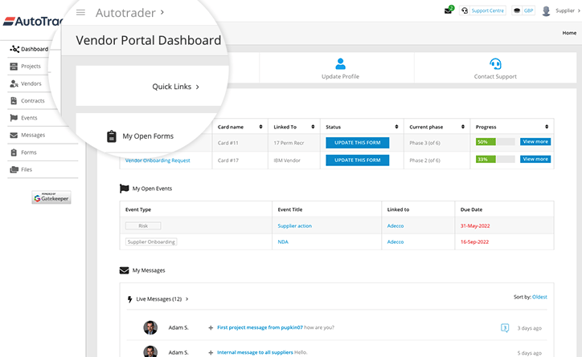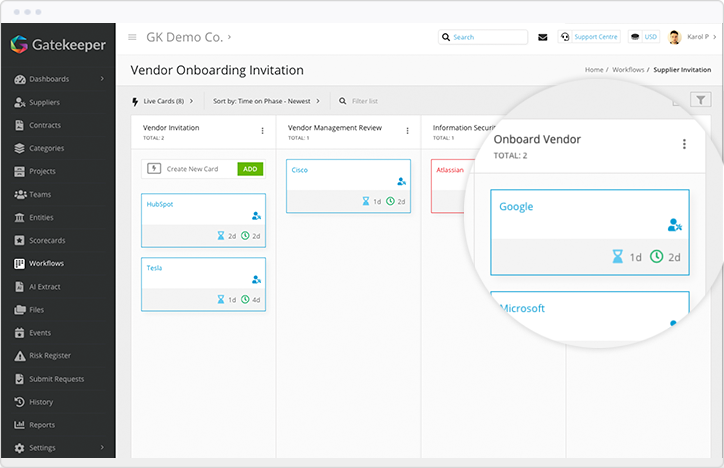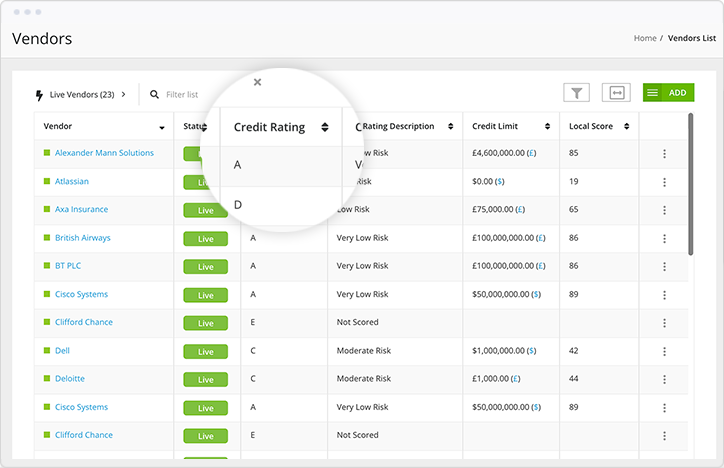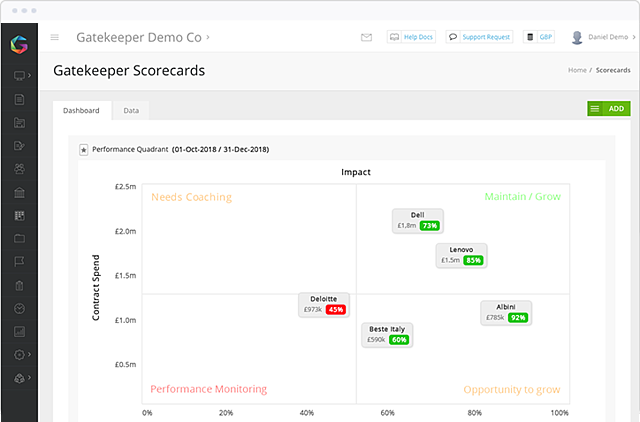Supplier management relies on the ability to develop long-lasting and mutually beneficial relationships.
Building these relationships doesn’t just rely on successfully nurturing external parties, it also requires stakeholders to analyse the value these relationships bring to the business and identify areas of improvement.
A qualitative and quantitative approach, underpinned by technology, is needed.
Supplier management is more than holding regular meetings with third parties. It’s also about knowing:
- How much time was invested in onboarding suppliers?
- Have there been any instances of non-compliance within the supply chain?
- Are they fulfilling all of their agreed obligations?
- What level of risk does each supplier add to the business and how can it be minimised?
- Can other suppliers offer you better terms than your current agreement?
Gaining these insights is particularly difficult when managing suppliers manually. Without visibility of outputs, current progress or obligations you won’t be able to answer the questions above. In this article we explore how supplier management software can help to improve your understanding, your relationships and the value suppliers bring to your business.
Why you need supplier management software
The way you manage your suppliers can impact the way they perform and, by extension, the way that your business performs. Using manual methods limits visibility, fosters fragmentation and slows down collaboration.
This can cause frustrations and depending on the quality of the supplier’s experience, can lead to a breakdown in the relationship. But if the supplier relationship fails, both parties risk losing a significant amount of time and money.
Supplier management software improves and streamlines processes. By streamlining processes such as onboarding, suppliers are given a better experience which forms the basis of a great relationship. It’s also designed to give you better insights about your suppliers - helping your business to decide if they should be rewarded, reprimanded or consolidated.
With the right software in place your business can:
- Improve collaboration with suppliers
- Track supplier performance and take early, remedial action if something isn’t right
- Easily identify and mitigate supplier risk
- Manage third-party compliance and obligation fulfilment.
Your business needs supplier management software to get the most value from its agreements while ensuring business continuity."
Let’s take a look at five areas where the right solution can make a practical difference within your organisation.
1. Manage suppliers through a dedicated portal
Supplier management software allows you to manage your relationships from a central portal. This gives your business a single location where it can register, onboard and collaborate with third-parties. Supplier portals offer automation and self-serve capabilities that not only enhance the experience for those you’ve chosen to work with but also allows you to:
- Delegate data input and hold suppliers accountable for providing complete information
- Create efficiencies within the onboarding processes so agreements can start more quickly
- Centralise and track communications with suppliers to increase transparency between parties
Supplier management requires a delicate balance between control and trust. Using a dedicated portal creates a personalised and collaborative experience for everyone involved. By improving collaboration and transparency between both parties, a more trusting business relationship can be built. The more inputs you can delegate to your third parties, the easier supplier management will be.
 The dedicated Supplier Portal from Gatekeeper
The dedicated Supplier Portal from Gatekeeper
2. Automate Supplier Onboarding
Manually onboarding suppliers requires dedicated time and resources. Activities can include updating records, chasing external parties for documentation and ensuring internal stakeholders are taking timely action. Bottlenecks can occur if there are delays by either party or if there is limited visibility of progress.
A seamless onboarding process will get your relationship started on the right foot. A provider that combines a dedicated supplier portal with a powerful workflow engine is the key to automating the experience. The benefits include:
- Visibility of supplier invitations, registration and performance reviews
- Automated notifications and reminders sent to suppliers based on key dates
- A messaging centre for easy communication with suppliers
- Standardised processes for each time you onboard a supplier
- A clear view of who has ownership of each phase to prevent bottlenecks
Automating supplier onboarding saves time for both Procurement and Legal teams. There’s no need to manually chase suppliers, track key dates or to work with outdated information. Everyone in the organisation can see a supplier’s onboarding progress, identify delays and take remedial action to get the relationship back on track.
 Automate the vendor onboarding process with Gatekeeper
Automate the vendor onboarding process with Gatekeeper
3. Mitigate supplier risk
Working with suppliers inherently increases risk. Without in-depth knowledge of who you are onboarding or how existing suppliers are currently performing, this risk can be significant.
Your business could face financial penalties and a damaged reputation if services aren’t delivered on time or your supplier’s compliance information is outdated.
Supplier management software helps you to minimise risk before you start a relationship. By only engaging with viable suppliers, you can have a greater level of trust in who you’re working with from the outset.
Choose supplier management software that offers integrated risk intelligence feeds. Access real-time information about your supplier’s credit score, litigation issues and changes in ownership.
This market intelligence can also be used to inform decisions about current relationships. If a supplier’s risk increases or financial status declines, you can take early remedial action.
This action can include conversations with them about potential impacts on your organisation. Or it can be as serious as consolidating your supplier base at the next review point.
Accessible and visible information about your supplier’s risk and changes to their business will help you to protect your organisation. You can minimise risk at every stage of the relationship, ensuring that business continuity is established.
Supplier management software helps you to identify current and potential issues, rather than risks being hidden in a spreadsheet. Risk monitoring, assessment, and prevention become automatic and integrated processes rather than other options that requires additional resources.
 See supplier changes, related to risk and compliance, in real time
See supplier changes, related to risk and compliance, in real time
4. Track and report on supplier performance and spend
Deep understanding, engaged stakeholders and fulfilled obligations are key criteria of successful supplier relationships. If visibility of performance and spend is being obstructed by manual management, your business won’t achieve the results it expects. Undetected poor performance and overspend leaves your business vulnerable to disruption.
Gatekeeper provides dedicated modules and customisable dashboards for supplier performance and spend. Having this knowledge readily available and in a shareable format means the entire organisation can discuss the results delivered so far and make recommendations for improvements moving forward.
Suppliers can also be held accountable for their actions - or lack of. Difficult discussions can be supported with factual information. Being able to track and report on performance and spend increases transparency between your business and its suppliers. Ultimately, reporting is a way to review the value of your relationships and how much their outcomes are worth.
 Measure supplier performance with Balanced Scorecards
Measure supplier performance with Balanced Scorecards
5. Manage data effectively through integrations
Managing your suppliers effectively requires knowledge, visibility and access to accurate data. Sharing this information between platforms needs to be seamless otherwise suppliers may default to not actively sharing information at all. This will reinforce manual tasks for your teams such as emailing and calling for follow ups.
Disjointed data between your suppliers and your business is a quick route to miscommunication and poor decision making.
Supplier management software can join up the dots with native integrations. Gatekeeper offers Salesforce, NetSuite and Zapier. By integrating with tech-stacks that your business and its suppliers are already comfortable with, usability will increase. Start to benefit from elements such as full system status synchronisation to make data sharing easier.
Wrap Up
Supplier management software can be used to create transparency, streamline processes and enhance your existing relationships. It eliminates the manual processes that can create bottlenecks, limit visibility and increase risk across your supplier base. This technology is crucial whether your business is well established, still in a growth phase or simply looking to refresh its relationships.
If you’re ready to learn more or want to know how supplier management software can benefit your business, book a demo today.

.png)
.png)
.png)
-4.png)